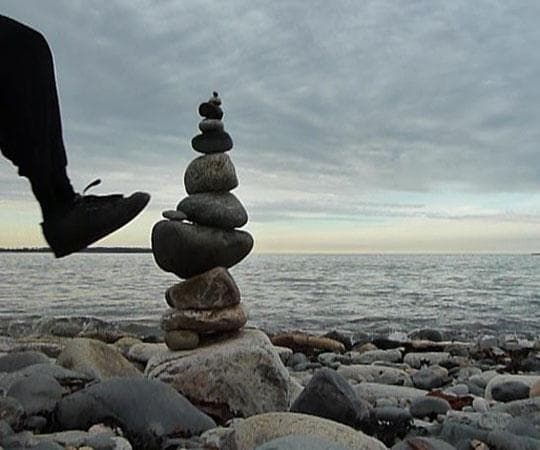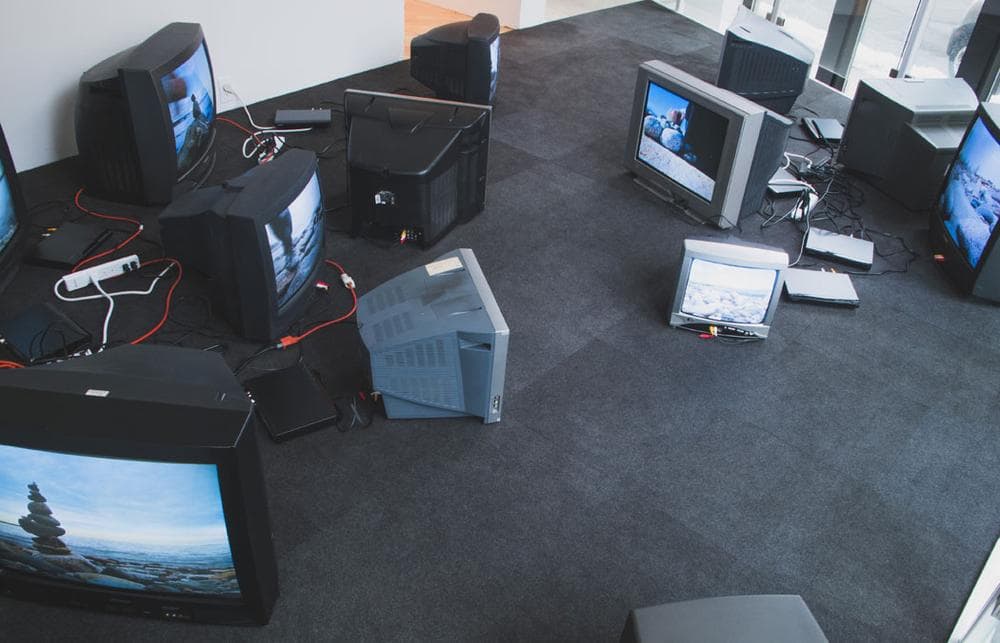Advertisement
Knocking Them Down: ‘Wendy Richmond Rocks TVs’
The Revolution may not have been televised, but it was certainly recorded. Thanks to YouTube and the iPhone, virtually anyone can watch the twentieth and twenty-first century’s most seismic moments anywhere, anytime, untethered from the bulky TV sets and nightly news broadcasts that once anchored the American home-life. Global events, be they newsworthy or not, play out in real time from one’s palm, on one's personal tablet, threatening the TV, as well as the particulars of time, place and personage, with obsolescence.
In her last few bodies of work, New York artist Wendy Richmond has used cell phones and laptops in order to investigate how we negotiate the surveillance culture of the Information Age. In her latest work, the installation “Wendy Richmond Rocks TVs,” on view through April 27 at Carroll and Sons Gallery in Boston, she goes back to the beginning, using videos on televisions to explore how we come to know and remember a place or time.
Like a slogan, the title “Wendy Richmond Rocks TVs” is as declarative as it is descriptive of this installation. Situated in the gallery’s newly renovated back corridor, the work is composed of 80 short videos of Richmond destroying haphazard rock towers, or “cairns,” she found last summer while vacationing on the coast of Maine.
Varying in length, perspective and atmosphere, the videos play on 13 TV sets placed directly on the floor and networked throughout the space in a snaking flow of wires and chords.

In every video, Richmond is the only participant, and in each, we see a simple rock structure sitting peacefully on a craggy, scenic beach before she casually approaches and knocks it down with her hand or foot. Once distinguished by a beachgoer for selection in their sculpture, the rocks are returned to the shore, as they would have been by fast-approaching waves had Richmond not intervened.
Together, the videos sound off in a layered dissonance that eerily evokes the reverberation of waves from underwater. At each video’s conclusion, we see the beach as if it were never touched by human hands, which is as much an idealization as it is tourism-industry advertised.
The bucolic setting of the videos, as well as Richmond’s participation in them, is somewhat of a departure from her previous works. In 2009’s “Public Privacy,” which was exhibited at Carroll and Sons, she used her cell phone to film people going about their daily lives on the streets of New York. In 2012’s “Navigating the Personal Bubble” at the RISD Museum in Providence, she gave selected participants specific instructions to record themselves at work on their laptops in busy public places through their computers’ built-in cameras. In these works, Richmond probes the tensions between old and new personal technologies by examining how they contour contemporary life.

As in her earlier work, the technique of “Wendy Richmond Rocks TVs” is to choose the setting, begin recording and document what happens. Here, however, Richmond is an active participant, while other people become passive, only present through their rock creations. Presumably these people were so moved by the setting’s beauty as to want to become a part of it through commemorating their presence with a sculpture. Conversely, Richmond’s attempt to connect to the natural landscape moves her to comically destroy other people’s monuments like a Saturday morning cartoon character might. Instead of commemorating, she disrupts. Her actions are analogous to evolutionary violence and only evidenced through her own recordings.
So it’s the same as it ever was—orders are built and toppled, land erodes into water. Except that it’s not, as “Wendy Richmond Rocks TVs” so smartly and humorously demonstrates. No moment or place is ever exactly the same as the last, and difference is merely mediated for us by an anonymous camera operator broadcasting through the latest gadget.
Leah Triplett, a Boston-based arts writer, was recently accepted to the Writers’ Room of Boston as a finalist for its Emerging Writer Fellowship. She also works as director of Martha Richardson Fine Art.
This article was originally published on April 04, 2013.
This program aired on April 4, 2013. The audio for this program is not available.